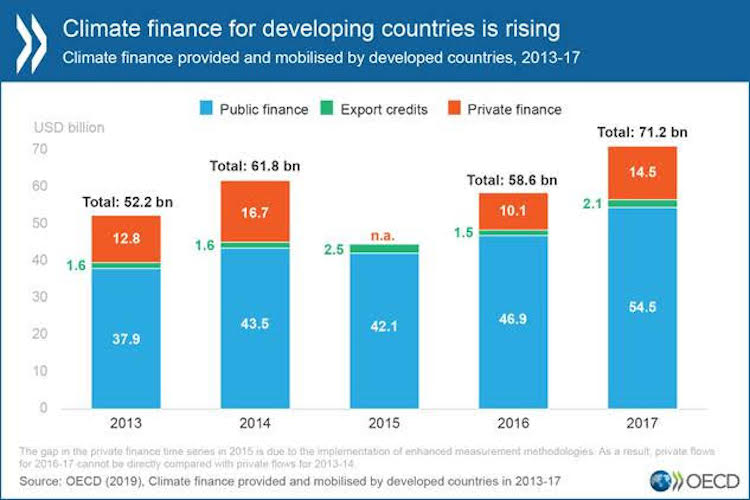
By Robert Johnson
PARIS (IDN) – A new report will call for attention when climate finance provided and mobilized by developed countries for climate action in developing countries is discussed at the Climate Action Summit at the UN in New York on September 23 and in the run-up to the COP25 climate talks in Santiago de Chile in December.
This report finds that while climate finance reached USD 71.2 billion in 2017 – marking an up from USD 58.6 billion in 2016 – it fell short of the goal to be reached by 2020.
But the OECD Secretary-General Angel Gurría assures that the goal to reach USD 100 billion in annual climate finance by 2020 is still attainable. “But we must urgently step up our efforts to provide public climate finance and improve its effectiveness in mobilising private finance,” he adds.
The report has been prepared by the OECD (Organisation for Economic Co-operation and Development) in response to a request by developed countries to help them better understand public climate finance trends. I
The OECD eestimates for 2013-2017 show that developed countries are making progress on climate finance and “the indications are that this upward trend will continue”. Multilateral development banks, for example, are reporting a significant rise in their climate finance outflows in 2018.
The amount of climate finance going to adaptation activities rose to USD 13.3 billion in 2017 from USD 9.1 billion in 2013, meaning adaptation now accounts for 19% of total climate finance, up from 17% in 2013. The share of climate finance going to mitigation activities was 73% in 2017, compared to 76% in 2013, with the rest going to crosscutting activities.
For public climate finance, the ratio of grants to loans was relatively stable over 2013-17. Grants made up over a third of bilateral and about 10% of multilateral finance, while loans represented 60% of bilateral and nearly 90% of multilateral finance. The share of grants in public climate finance in 2016-17 is higher for least-developed countries (36%) and small-island developing states (54%) than for developing countries as a whole (24%).
The report points out that the private component of climate finance consists of private funding for climate projects mobilised by developed countries’ public climate finance instruments. These include investments in companies and special purpose vehicles, loan guarantees, credit lines, loan syndications and co-financing schemes.
The public component consists of bilateral climate finance and multilateral climate finance attributable to developed countries. Officially supported climate-related export credits are accounted for as a separate component.
Read the report > https://www.oecd.org/environment/climate-finance-provided-and-mobilised-by-developed-countries-in-2013-17-39faf4a7-en.htm [IDN-InDepthNews – 16 September 2018]
Image credit: OECD
IDN is flagship agency of the International Press Syndicate.
www.facebook.com/IDN.GoingDeeper – https://twitter.com/InDepthNews











